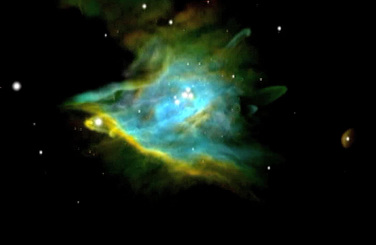The jewel of Orion is the Great Orion Nebula, a vast stellar nursery where new stars are still being born.
Clouds of Gas
Look six moon widths south of the belt stars in the sword of Orion. The hunter's sword may look like a vertical line of stars, but, if you look very closely—a telescope really helps—you'll see that most of these stars are actually nebulous clouds of gas.Look six moon widths south of the belt stars in the sword of Orion. The hunter's sword may look like a vertical line of stars, but, if you look very closely—a telescope really helps—you'll see that most of these stars are actually nebulous clouds of gas.
The Orion Nebula, also known as Messier 42, is visible to the naked eye as a fuzzy patch in the middle of Orion's sword.
What we call the Orion Nebula is really just the central part of a larger cloud that stretches across several hundred light-years. Four bright stars in a parallogram near the nebula's center form the Trapezium. These hot young stars heat up the surrounding gas clouds. Like a free-form fluorescent light bulb or neon light, the gas clouds light up in response to energy from these stars. The Orion Nebula is full of hot, bright blue stars and is an area of active star formation.
Let's see some of that star-birth in action.
This movie takes you deep into the Orion Nebula, diving down into what look like small nodules of dust. They're actually not small at all! Each one is a cocoon for a new star. They're called proplyds.
Watch closely as we speed up time. You can see the rotating dust and gas squeeze itself together—enough to begin the nuclear fusion reaction that powers a star. And each of these proplyds likely contains enough material to nurture not only a single star, but possibly planets and, more often than not, even a second star!
M42 is a veritable catalog of different object types, including multiple stars and reflection-plus-emission nebulosity.
The wealth of detail visible in this nebula through a telescope is simply gorgeous. Intricate wisps, shapes, and the contrast between brighter and darker regions never cease to spark the imagination.
